No, not Reflections in a Golden Eye. Neither Marlon Brando nor Elizabeth Taylor will be making an appearance and there will be no murder.
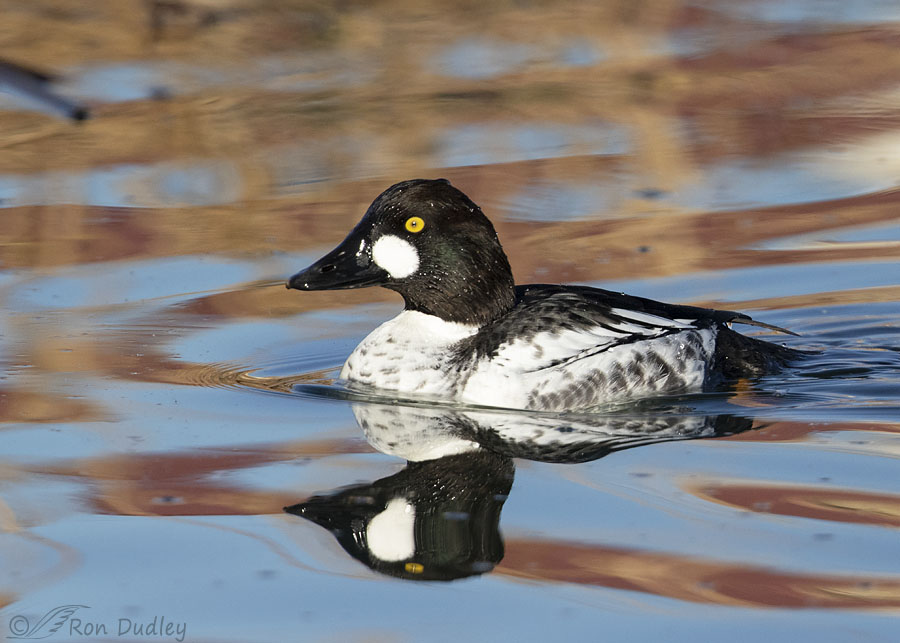
1/5000, f/6.3, ISO 800, Canon 7D Mark II, Canon EF 500mm f/4L IS II USM + EF 1.4 III Extender, not baited, set up or called in
This male Common Goldeneye was another one of my subjects four days ago when I was photographing birds from my tripod in the freezing cold. I usually have trouble getting close to goldeneyes but this guy came to me because he wanted to fish in a small cove to my left that was close to where I was standing. As a result, some of my photos below don’t give him quite as much room in the frame as I’d prefer.
I still like these photos for several reasons, including the detail I got on the duck and the…
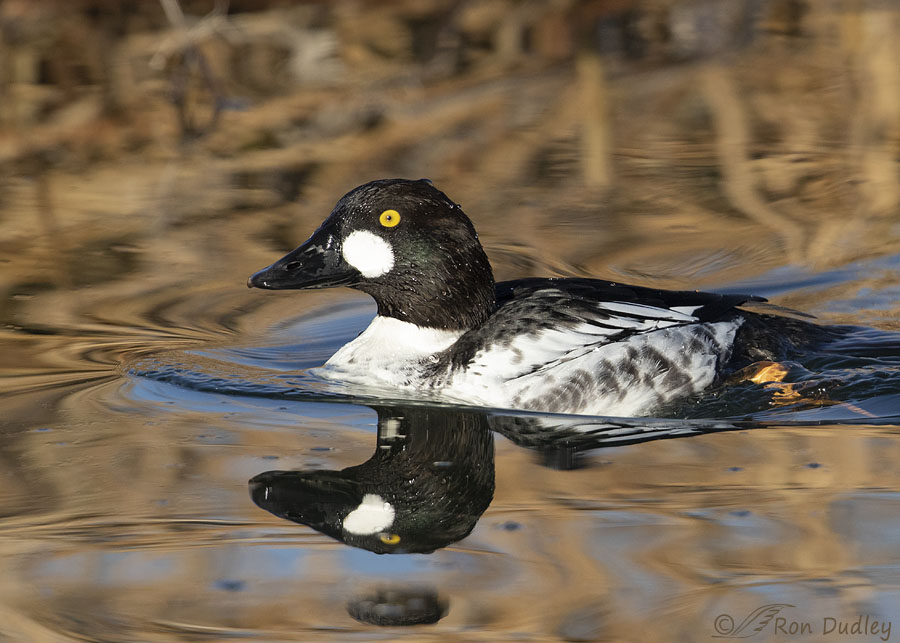
1/3200, f/6.3, ISO 800, Canon 7D Mark II, Canon EF 500mm f/4L IS II USM + EF 1.4 III Extender, not baited, set up or called in
reflections in the water – of both the duck and the…
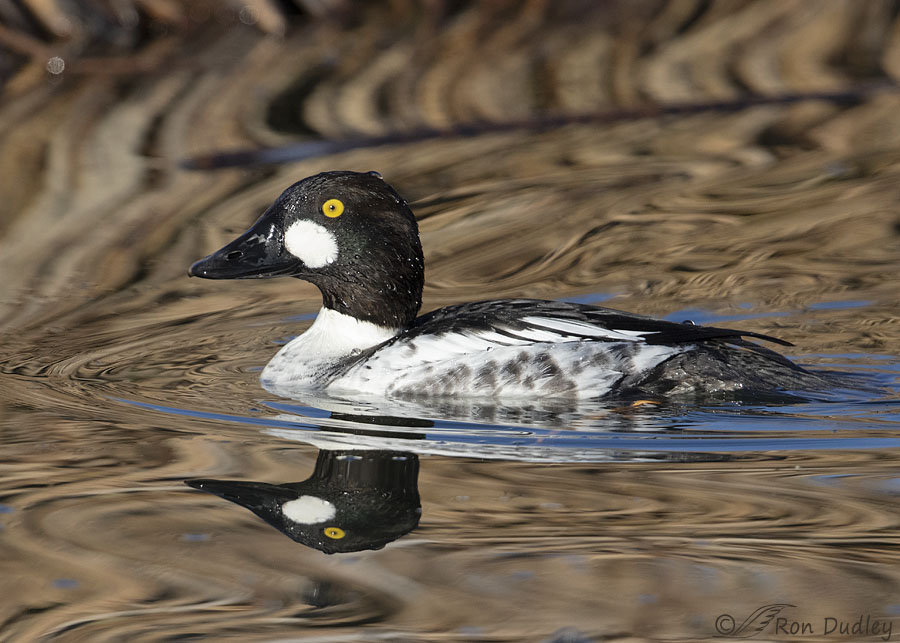
1/4000, f/6.3, ISO 800, Canon 7D Mark II, Canon EF 500mm f/4L IS II USM + EF 1.4 III Extender, not baited, set up or called in
swirly reflections of the phragmites above and behind the bird.
Readers already know that one of my goals that morning was to photograph ducks as they were diving and catching them just before their eye entered the water. From yesterday’s post of the diving Redheads you also know that the timing of my reflexes consistently caused me to fail because the second shot in my burst always caught them just after their eye entered the water instead of before. More on that in a minute.
There are at least three clues in this photo suggesting that the duck is about to dive. Can you spot some of them?
- Many ducks, if they’re swimming forward, stop in the water just before a dive. Notice that this duck is dead in the water The bow wave in the previous photos of him swimming forward no longer exists – only the ripples left over from it.
- They tend to hold their head a little more erect just before a dive.
- They usually have what I call a “wide-eyed look” just before a dive. I can see it in this photo but it’s hard to explain because his eye is only barely open wider than it was before. It’s just a look I recognize – don’t ask me how.
So when I noticed those clues I began to fire off a burst and sure enough…
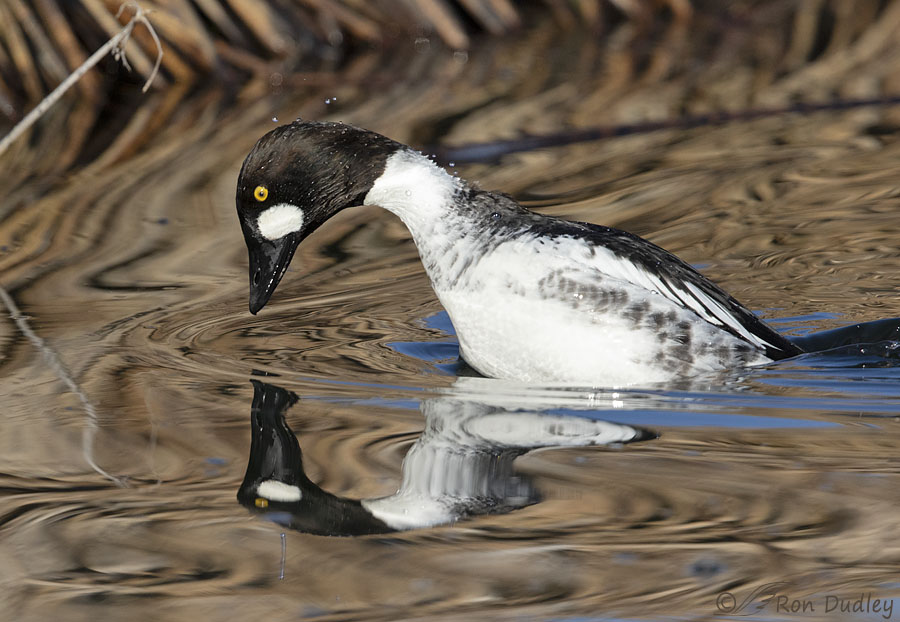
1/4000, f/6.3, ISO 800, Canon 7D Mark II, Canon EF 500mm f/4L IS II USM + EF 1.4 III Extender, not baited, set up or called in
he dived almost immediately. This is the first shot in the burst. Did the second shot in my burst catch him just before his eye entered the water?
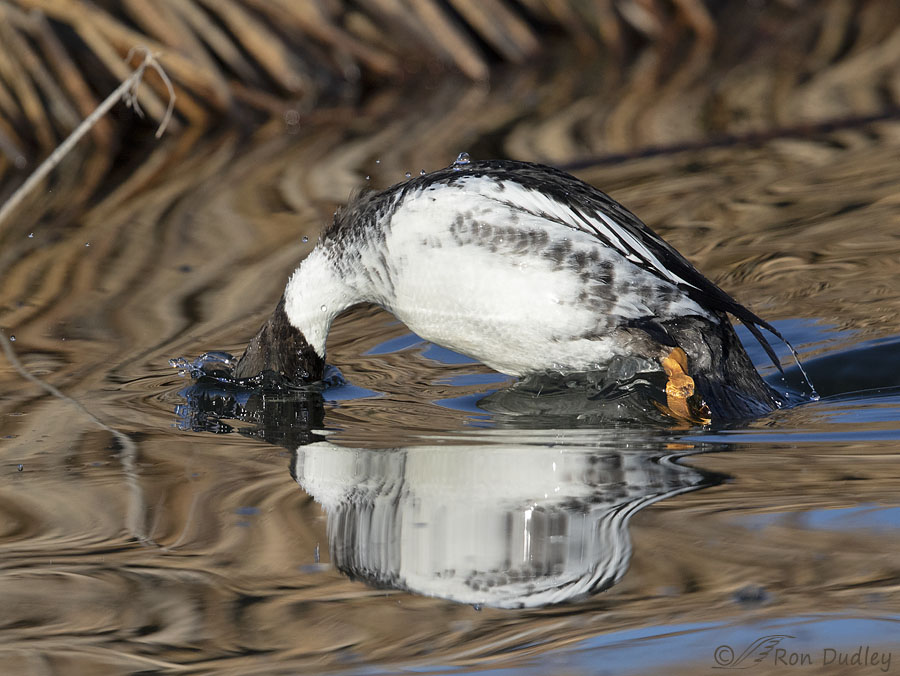
1/5000, f/6.3, ISO 800, Canon 7D Mark II, Canon EF 500mm f/4L IS II USM + EF 1.4 III Extender, not baited, set up or called in
Nope. I caught him at the same stage of the dive as I did in all my Redhead diving photos taken a few minutes earlier, with his eye just below the water instead of above where we could see it. I failed again but at least I’m consistent. Aggravatingly so.
In this dive the goldeneye also failed in his attempt to catch breakfast but…
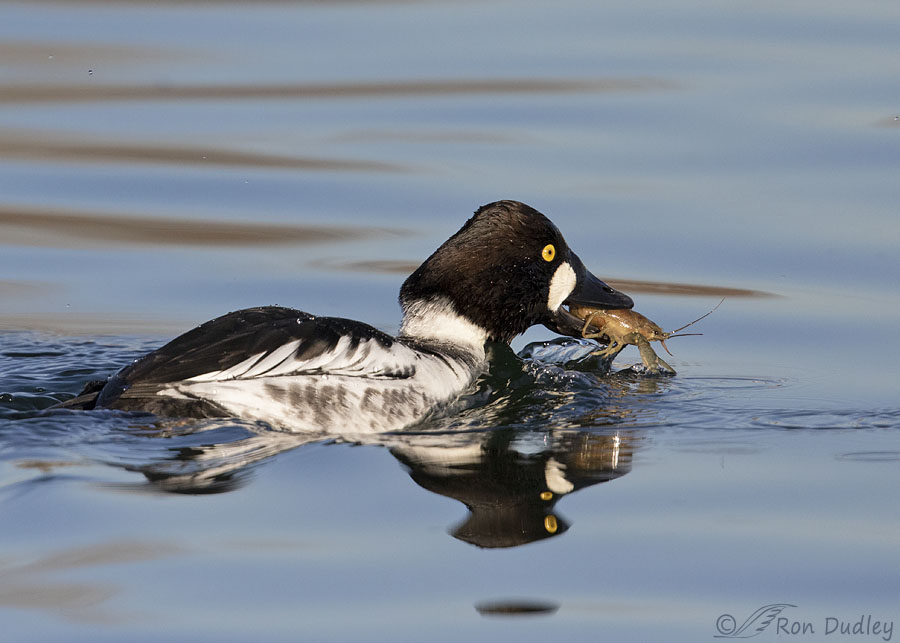
1/5000, f/6.3, ISO 800, Canon 7D Mark II, Canon EF 500mm f/4L IS II USM + EF 1.4 III Extender, not baited, set up or called in
just a few minutes earlier he’d been successful when he caught this crayfish and eventually gobbled it down without ever facing me to give me a better photo. The crayfish was large enough that I’m just a little surprised that he was still hungry enough to hunt after swallowing it.
But he was and he did.
Ron


Love learning something new and seeing the world through the eye of a remarkable photographer. I had to look twice at the “prepare to dive” shot, and your instructions as to what to look for were really helpful.
Not sure about Liz, but I think this Goldeneye could make you an offer you couldn’t refuse.
Thanks, Marty. It it probably took me longer than it should have to pick up on some of those diving cues. But now I recognize them almost instinctively.
Interesting information on a very elegant bird…
Thank you, Patty.
Ron – The beauty of your photos is a given, now. But even more important for your audience, I think, is that you teach us how to see. Showing us the subtle differences between #2 and 3, “hanging out” vs “preparing to dive”, and explaining so clearly so that we can see what you instinctively know – WOW!
Your biology classes must have been so much fun.
Thank you for a wonderful start to the day!
“Your biology classes must have been so much fun.”
I tried to make them so, Carolyn. I think I often succeeded but some of my former students may have a different take on that…
I appreciate what you said very much.
This is a great series, professor! The subtle head raise is locked in my brain now.
Good. Locked = remembered. Thanks, Arwen.
Hah! Re: the clues that the duck was getting ready to dive: my first thought was a jokey comment on how bright the already bright eye was, “Well, the duck’s eye sure looks brighter.” Nyuk, Nyuk. I guess I noticed something different about the eye….I did notice the lack of bow wave.
The rippled water with the wavy phrags is beautiful. Thank you for these great shots of this duck. They never sit this still for me when I see them. Nyuk……
Kathryn, this one didn’t sit still much either, except briefly when he was about to dive.
Bummer about the missed shot but I really, really like that ‘prepatory’ shot.
Thanks Ron. I am a v grumpy piece of work this morning and this was a very welcome distraction.
Sorry about your grumpiness this morning, EC. I hope its cause just gets up and vanishes.
Thank you. Sadly no. I will have to adjust and learn to live with it.
Intriguing cues you have proposed for pre-dive behavior. I’ll see if I can tune into those. Do you see those “tells” in other diving ducks, e.g., Redheads?
Not “On Golden Pond” either; no Katherine or Henry or Loons, but I like your Goldeneyes just the same
“Do you see those “tells” in other diving ducks”
Yes, Lyle – often but not always. To one degree or another and with some variations. And with some diving birds other than ducks, grebes for example.
Wonderful series—I think the swirly phragmites patterns are a
dynamic addition to the “action” of the duck–and noticed that in most of
the images, a reflection of the blue sky ringed the body of the duck, but the rest of the surface reflected the bronzed weed pattern–wondered why ?
“wondered why?”
Kris, that happens because ripples and flatter water have differing angles. So some angles reflect the sky and others reflect the phrags.
Wow, really enjoyed these. It is a very interesting eye expression just before it dives! Thanks, Ron
Thank you, Mary.
Ron: I have come to enjoy reading and viewing your posts every day since I discovered you this past Spring. However, it occurred to me, when I read this in your post today: “he wanted to fish in a small cove to my left that was close to where I was standing”, that I would really appreciate seeing a wide angle shot of your surroundings as you describe your photos. Funny, but I feel a bit claustrophobic as I read and view your blog. A picture of your surroundings would put everything more into focus, so to speak. Thanks again, Malon
I’m glad you’re enjoying them, Malon. Occasionally I post photos like you describe but for several reasons I’m pretty selective about when I do it.
Nice! Interesting and fun how different each of the reflections are in each shot. Certainly would have thought the crawdad was enough of a meal to last awhile tho may be more “roughage” than actual food….
Certainly would have thought the crawdad was enough of a meal to last awhile tho may be more “roughage” than actual food….  As fast as your burst rate it it’s impressive that it just isn’t quite fast enough – dive shot IS impressive even without the eye.
As fast as your burst rate it it’s impressive that it just isn’t quite fast enough – dive shot IS impressive even without the eye.
Judy, my burst rate of 10 frames/sec used to be considered fast. No more…
Great series, esp #4 and the crayfish one. The mirror-like water and reflections and ripples are the sprinkles on the sundae.
Thanks, Granny Pat. I never liked sprinkles on anything but I’ll make an exception in this case.
Outstanding series Ron. I have always appreciated reflection photos and in particular I like the ones with the swirly reflections from the phragmites etc. And thanks for the tips on how to know when they are going to dive. You surely have to be really quick to catch them before the eye goes under.
Thanks, Everett. Yup, quick and lucky.